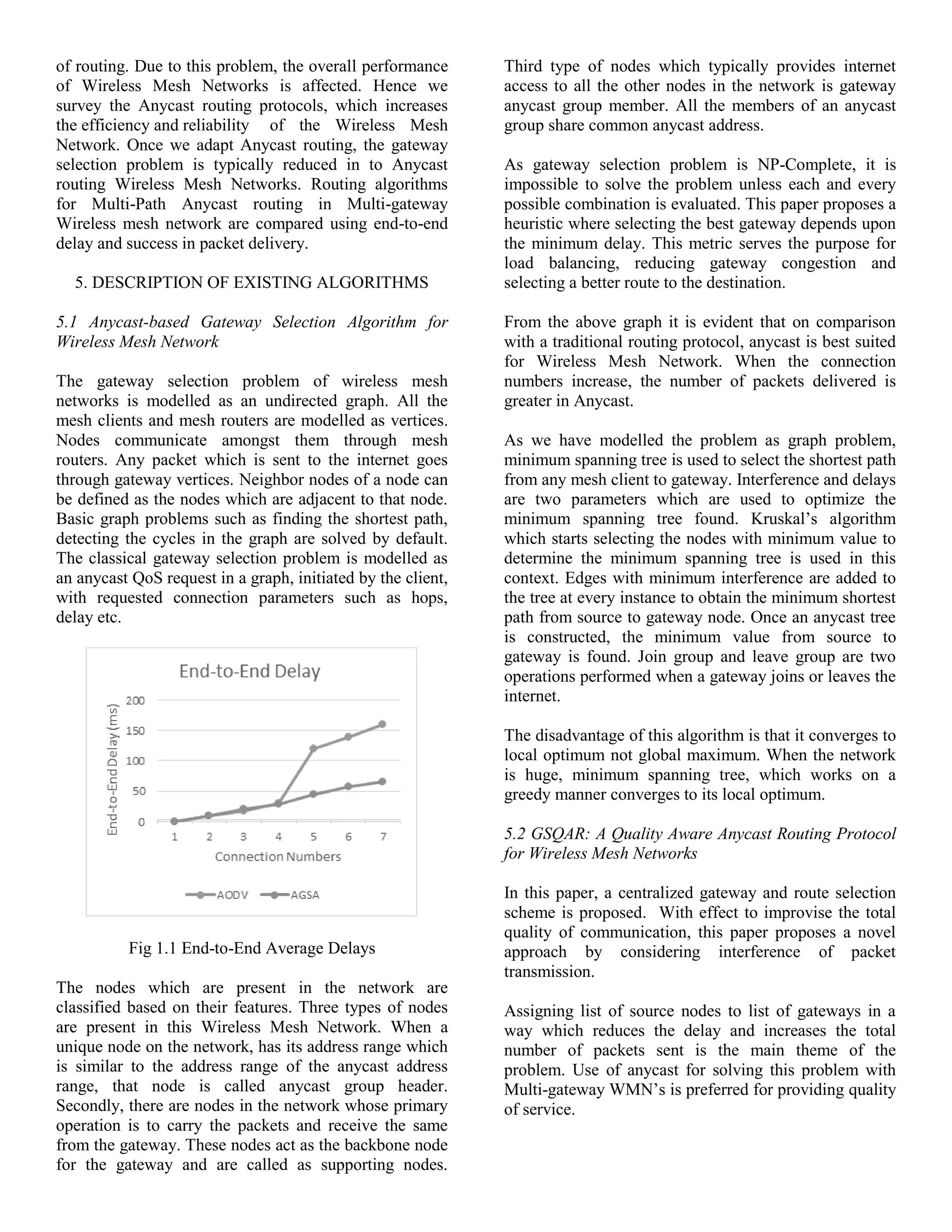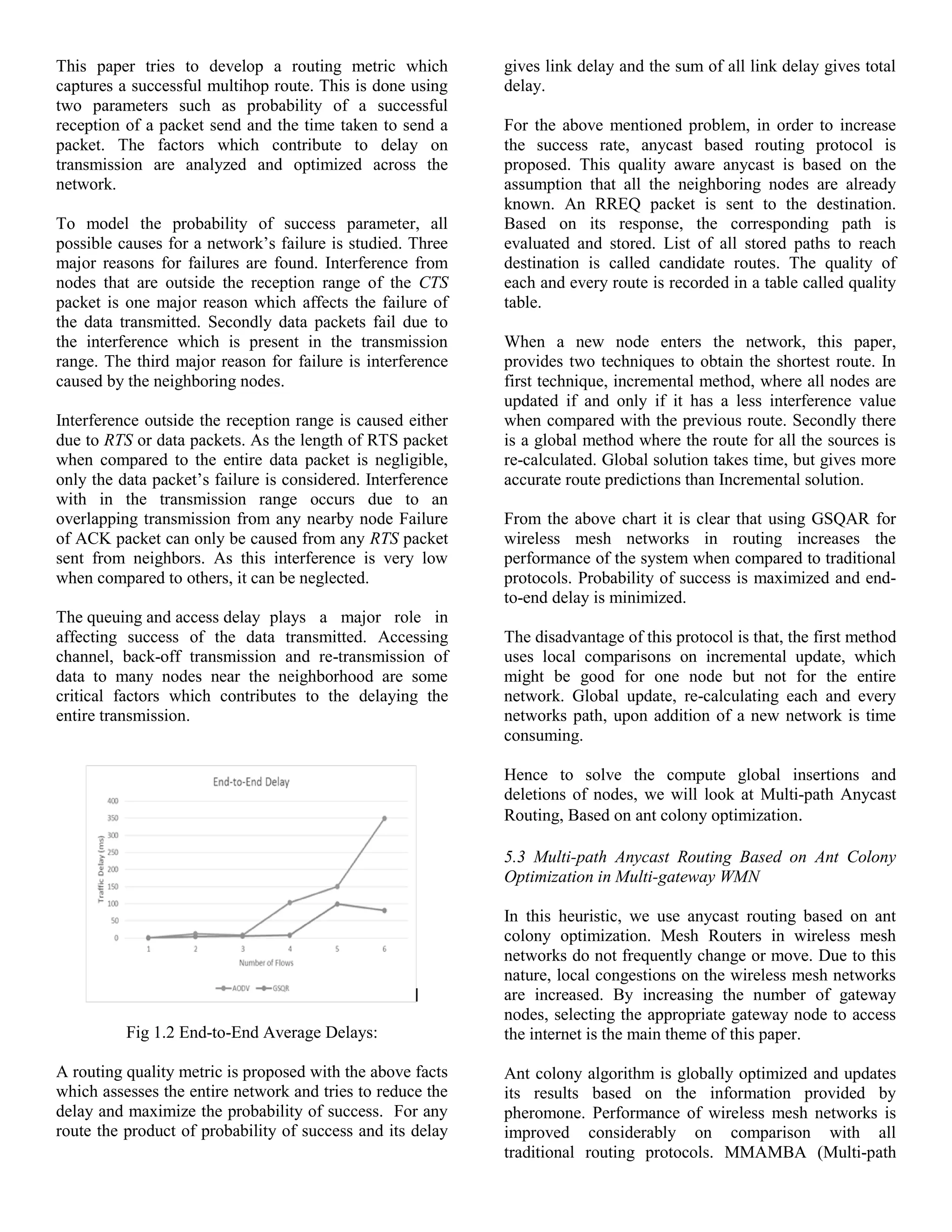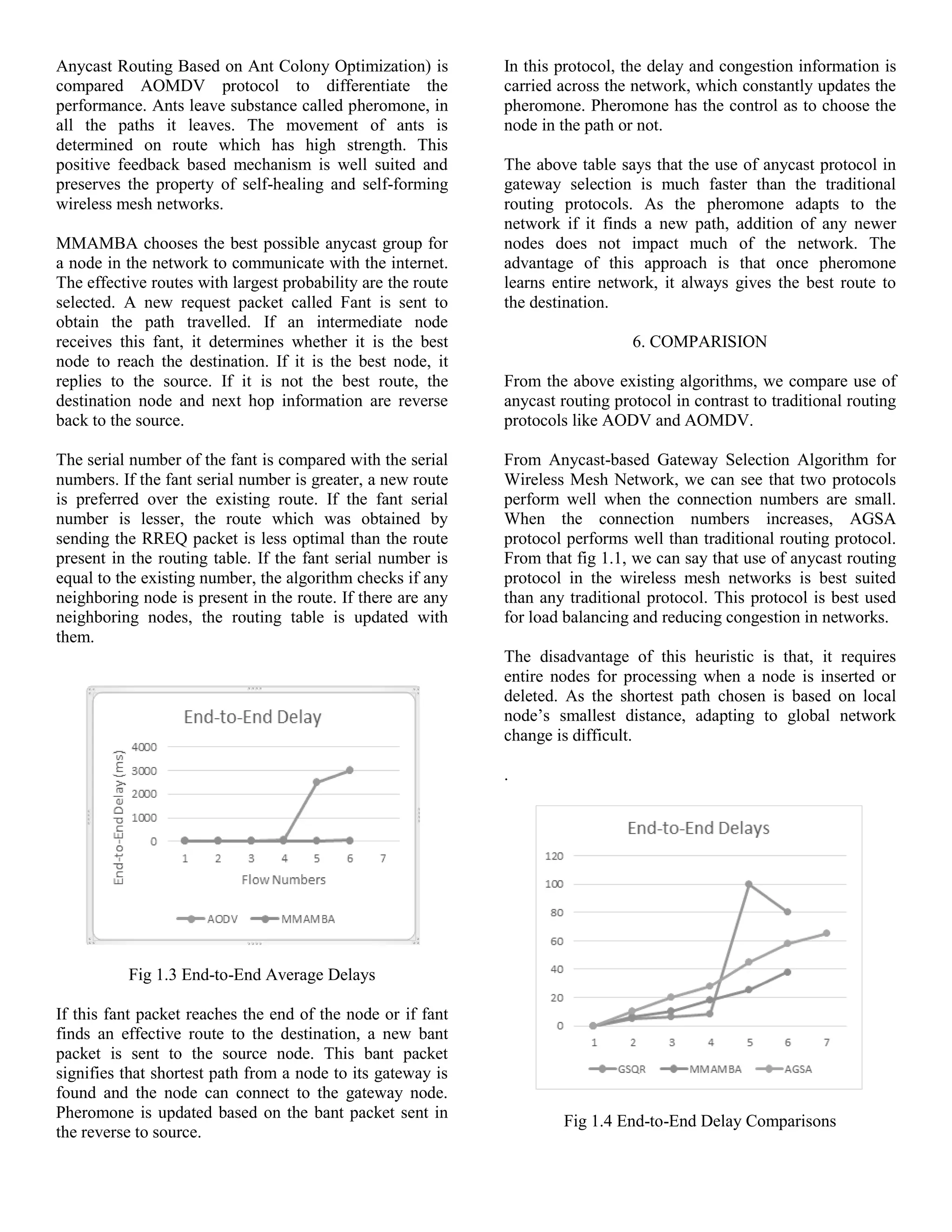This document summarizes a survey on routing algorithms for anycast in wireless mesh networks. It discusses how using anycast-based routing instead of traditional routing can improve network performance by better selecting gateways. Three popular anycast heuristics are examined: one optimizes load balancing, another improves quality of service and minimizes interference, and a third uses ant colony optimization. The survey compares these anycast implementations to AODV routing and determines the best approach for wireless mesh networks adapts to select gateways.
![Survey on Routing Algorithms for Anycast in Wireless Mesh Networks
Chandrasekar Hariharan (U00745288)
hariharan.11@wright.edu
Abstract:
Using Anycast based routing algorithms instead of
traditional routing algorithms, increases the
performance of the wireless mesh network. Selecting
an appropriate gateway over many available
gateways is the main problem discussed in this paper.
As this gateway selection problem is NP-Complete, a
heuristic based approach is used. Three popular
anycast based heuristics is applied for gateway
selection problem. First heuristic uses anycast based
algorithm to optimize load balancing parameters in a
distributed Wireless Mesh Network. Second heuristic
uses anycast based routing algorithm to improve the
quality of service and minimize interference of the
entire network. Third heuristic uses ant-colony based
heuristic to optimize the entire network. Traditional
protocol, AODV, is compared with all three anycast
implementations and best routing protocol to use in
wireless mesh network is determined. The proposed
survey indicates that adapting based approach, (i.e)
find the appropriate gateway adaptively, is best
suited than an approach which considers fixed route
from source to destination.
Keywords: Anycast, Pheromone, Ant-Colony,
GSQAR, MMAMBA, AGSA.
1. INTRODUCTION
Wireless mesh network is a form of wireless ad hoc
network which is made of radio nodes such as clients,
routers and gateways, typically well organized in a mesh
topology. As the usage of broadband internet has
substantially increased, the need for reliable, fast and
low cost networks has increased.
This tem paper is part of the course work of CEG-7470-Advanced Wireless
Networks, to be submitted on 12/10/2014. The instructor- Dr. Bin Wang
Author- Chandrasekar Hariharan, with graduate school in wright state
university, in the computer science department, 3640 colonel glenn hwy,
Dayton, oh 45324 USA (E-mail : Hariharan.11@wright.edu).
Wireless Mesh Network is one such network, which is
reliable and can communicate with rest of the nodes in
the network even if one node is not functional. The
important property of this network is that this network
can self-form and self-heal in-case of any problem. In
this network, multiple gateways are used to transfer data.
Selecting the appropriate gateway so as to increase the
total communication quality, balance network load and
minimize optimal cost is gateway selection problem.
An Anycast address selects one best server among group
of servers, thereby balancing the load and improving the
overall performance of this network. In Anycast
communications, the client needs no knowledge of the
location of server in obtaining an appropriate node
corresponding to a specific service.
Increasing the capacity of the network by selecting the
appropriate gateway node to communicate with
destination is an NP-Complete problem. Heuristics
based on Anycast routing protocol has been used to
solve this problem in an efficient way.
A gateway selection algorithm based on Anycast is
proposed so as to minimize the congestion occurring at
the gateways [1]. A Quality aware Anycast algorithm is
proposed for this problem, which is used for VOIP
communications, ensuring reliable transmission of data
over the network [2]. Multi-path Anycast Routing Based
on Ant Colony Optimization in Multi-gateway WMN
uses a heuristic called ant colony algorithm to preserve
both of the above mentioned properties [3].
Gateway selection algorithm is optimized using three
heuristics mentioned above. Each heuristic improves the
performance of the solution and results in relatively
better performance.
2. BACKGROUND
As all the clients share a common gateway to send data
across the network, the bandwidth of the network is
reduced. Due to the gateway bottleneck, the capacity of](https://image.slidesharecdn.com/110206ad-24ab-4bc5-8599-168c84350b8b-151016230746-lva1-app6891/75/AWN_FINAL_TERM_PAPER-1-2048.jpg)
![the network flow is greatly reduced. Throughput per
client and reliability of the network is greatly reduced
because of congestion in the gateway network. Anycast
routing network selects the best node amongst group of
servers [1].
The network load balance and resource management is
efficient when using anycast protocol [2]. From the
above two facts, it is evident that use of Anycast in
solving gateway selection problem, gives optimal results
than any traditional routing protocols.
GSQAR (Gateway Selection and Quality Aware Anycast
Protocol for Wireless Mesh Networks), proposes a
heuristic which solves the gateway selection problem for
a fewer number of packets. It increases the throughput
relatively better than the any random gateway selection
scheme. GSQAR minimizes the interference, congestion
and maximizes the throughput.
As we use Anycast to solve the gateway selection
problem, the gateway selection problem is reduced to
Anycast routing problem. So far there is no precise
method to solve this problem in polynomial time [4].
Ant colony algorithm solves combinatory and
optimization problems by simulating the conduct of ants.
Pheromone, a substance left by the ant on looking for
food is the parameter used to find the shortest path to the
destination. This is a heuristic, which comes under the
class of evolutionary algorithms, finds the optimal
gateway adaptively by choosing the best combination.
Ant climbs its way all along global maxima and does not
converge in to local maxima.
3. RELATED WORK
The simplest way for solving the gateway selection
problem is by measuring the number of hops from
source to destination. The advantage of this method is
that we can send a data packet from source to destination
in the shortest path. The disadvantage of this method is
that the gateway chosen to send a packet will be
congested easily [1].
An adaptive gateway discovery method was proposed by
ZHANG which establishes a route to the new gateway if
it detects any node is going to leave the network. The
space and time overhead for implementing this
algorithm is large for larger networks. Multi-Gateway
wireless mesh routing protocol uses Dynamic Source
Routing protocol to find the cheapest gateway in the
network. The route which receives the first
acknowledgment amongst all the paths is considered to
be the cheapest and best path. This algorithm does not
work well with failure in the network [2].
A multi-gateway association scheme is proposed, where
the shortest path from source to destination is found on a
greedy manner. By selecting gateway in this manner, the
solution most likely converges to a local maximum path
than a global maximum [2].
Another dynamic programming approach is proposed to
reduce the space and time required to solve this problem.
By this method, each and every node memorizes its
nearest gateway node. All the data packets sent are to its
nearest gateway node. The advantages of this method are
that the computations performed to send the data packets
along the shortest path is less. The disadvantage of this
method is that the gateway to which all the clients send
its packet will be congested [2].
Anycast based networks solves the problem of self-
healing and self-forming in Delay/Disruption tolerant
networks. In this method, genetic algorithm based
implementation is used so as to choose a population
which evolves through several mutations or re-
combinations, eliminates the overhead due to
delay/disruption. This is an important property which
can be inherited for use in to Wireless Mesh Networks
[3].
An efficient dynamic multicast routing protocol which
uses anycast for routing uses off-tree anycast routing and
on-tree dynamic routing. This protocol uses shared tree
based approach, which combine them to form a virtual
anycast group. Delay is used as a parameter to route
amongst all the nodes to find the shortest path. In on-tree
dynamic routing, the shared trees are used dynamically,
to route amongst the nodes. To ensure reliability in the
network, backup nodes are used; in-case if a deadlock or
node used to communicate to the destination is dead
[12].
Multipath routing provides increased throughput and
performance. Multipath networks provide good load
balancing support and finds best path than single path
routing. Mobile-adhoc-networks use multipath routing to
communicate faster. In this paper, two on-demand
methods have been proposed to search for a node. In a
distributed environment, searching for a node amongst
all its peers to send data is difficult. A new metric is
proposed in this paper to reduce the cost and time
required to search for a node in a distributed system
[13].
4. PROBLEM STATEMENT
A Wireless Mesh Network which has multiple access
points, communicate with in the network, using Access
Points. Gateway Access Point is flooded heavily when
compared to all the other Access Points due to the nature](https://image.slidesharecdn.com/110206ad-24ab-4bc5-8599-168c84350b8b-151016230746-lva1-app6891/75/AWN_FINAL_TERM_PAPER-2-2048.jpg)



![Hence we use anycast networks in the next heuristic.
This Quality Aware Anycast Routing Protocol for
Wireless Mesh Networks provides a heuristic which
focuses on quality of communication. On comparison
with traditional AODV protocol, this protocol provides
better quality of service and reduces the delay much
larger than expected. The quality metric used in this
process is effective. The simulation results show that
GSQAR is effective in improving both the throughput
and delay performance in mutlihop environments in
comparison to traditional routing protocols.
The disadvantage of this GSQAR approach is that it
takes more time on adapting to addition of new nodes.
Even though this protocol performs better than
traditional protocols, it takes much time to compare with
each and every node in the network and obtain good
results.
Finally MMAMBA protocol is used to provide better
results for this problem. Ant-Colony optimization based
approach is used in selecting the appropriate gateway of
the network.
Many factors such as delay, hop counts, load of the
gateway and quality of the network are considered and
an optimal path to the destination node is found
adaptively. This protocol overcomes the disadvantages
of dynamic node insertions and deletions, as pheromones
monitor the entire network and gives optimal path
solution.
Based on the above graph, the end-to-end delay is very
less in MMAMBA network in comparison with GSQR
and AGSA. This indicates the collective performance
and optimal route selection is best chosen by
MMAMBA algorithm.
7. CONCLUSION
From the above results, it is evident that use of anycast
protocol is best preferred when compared to any
traditional routing protocols. Comparing three heuristics,
we find that MMAMBA protocol is best suited in any
Multi-path, Multi-gateway wireless mesh network. The
first two anycast routing algorithms proposed are best
suited for load balancing, ensuring quality of service.
Pheromone based anycast selection approach used in
MMAMBA, works well amongst all the heuristics
proposed for optimizing proposed NP-Complete
problem. This protocol solves congestion of single
gateway problem, ensures higher throughput and lower
end-to-end delay.
8. FUTURE WORK
Future work includes integrating multiple channels with
multiple radios to reduce co-channel interference. Using
this adaptive MMAMBA algorithm in MANET to send a
data packet in the best optimal route to improve the
overall performance of the system can be done. Swarm
Optimization or genetic algorithm based anycast
implementations can be used as the input for ant-colony
optimization approach. As the inputs routes provided by
the algorithms are genetically improvised, time taken to
find an optimal path, (i.e) number of comparisons to be
done in the system is greatly reduced.
9. REFERENCES
[1] Zhihui, G., Taoshen, L., & Xiaolan, Q. (2010,
August). Anycast-based gateway selection algorithm
for Wireless Mesh Network. In Computer Science
and Education (ICCSE), 2010 5th International
Conference on (pp. 1699-1702). IEEE.
[2] Pal, A., & Nasipuri, A. (2010, December). GSQAR:
A quality aware anycast routing protocol for wireless
mesh networks. In Global Telecommunications
Conference (GLOBECOM 2010), 2010 IEEE (pp. 1-
5). IEEE.
[3] Ling, S., Jie, C., & Xue-jun, Y. (2010, August).
Multi-path anycast routing based on ant colony
optimization in multi-gateway WMN. In Computer
Science and Education (ICCSE), 2010 5th
International Conference on (pp. 1694-1698). IEEE.
[4] Jianxin Wang, Yuan Zheng, Weijia Jia. An Anycast
Protocol based-ADOV in MANET. The 14th IEEE
International Symposiun on Personal, Indoor and
Mobile Radio Communication, 2003.
[5] Kassabaldlsi,El-Sharkaw I W A,Marks R
J.Swarm intelligence for routing in
communication networks[J].Global
Telecommunications,2001,6(6):3613-3617.
[6] Changui Shin, SungHo Kim, Sunshin An.Stable
gateway selection scheme based on MANET with
Internet[C]. The Sixth IEEE International Conference
on Computer and Information Technology,Dhaka,
Bangladesh, 2006, pp.80.
[7] ZHANG Kaijie, XIANG Yong, SHI Meilin. Multiple
gateways-based Internet connectivity for mobile ad
hoc networks [J]. JOURNAL OF TSINGHUA
UNIVERSITY (SCIENCE AND TECHNOLOGY.
2007, 47(1): 100-103.
[8] R.Draves, J.Padhye, B.Zill. Routing in multi-radio,
multi-hop wireless mesh networks[C]. ACM Annual
International Conference on Mobile Computing and
Nerworking, Philadelphia, PA, USA, September
2004, pp. 114-128.
[9] L. Song and Z. bing Xia, “An anycast routing
protocol for wireless mesh access network,” ICIE,
vol. 2, pp. 82–85, 2009.
[10] D. Nandiraju, L. Santhanam, N. Nandiraju, and D.
Agrawal, “Achieving load balancing in wireless mesh](https://image.slidesharecdn.com/110206ad-24ab-4bc5-8599-168c84350b8b-151016230746-lva1-app6891/75/AWN_FINAL_TERM_PAPER-6-2048.jpg)
![networks through multiple gateways,” in IEEE
MASS, 2006, pp. 807–812.
[11] K. Sharif, L. Cao, Y. Wang, and T. A. Dahlberg, “A
hybrid anycast routing protocol for load balancing in
heterogeneous access networks,” in ICCCN, 2008,
pp. 99–104.
[12] Jia, W., Xu, G., Zhao, W., & Au, P. O. (2002).
Efficient internet multicast routing using anycast path
selection. Journal of Network and Systems
Management, 10(4), 417-438.
[13] Wu, K., & Harms, J. (2002). Multipath routing for
mobile ad hoc networks.Communications and
Networks, Journal of, 4(1), 48-58.
[14] Baumann, R., Heimlicher, S., Lenders, V., & May,
M. (2007, June). HEAT: Scalable routing in wireless
mesh networks using temperature fields. In World of
Wireless, Mobile and Multimedia Networks, 2007.
WoWMoM 2007. IEEE International Symposium on
a (pp. 1-9). IEEE.
[15] Rozner, E., Seshadri, J., Mehta, Y., & Qiu, L. (2006,
September). Simple opportunistic routing protocol
for wireless mesh networks. In Wireless Mesh
Networks, 2006. WiMesh 2006. 2nd IEEE Workshop
on (pp. 48-54). IEEE.
[16] Badia, L., Botta, A., & Lenzini, L. (2009). A genetic
approach to joint routing and link scheduling for
wireless mesh networks. Ad Hoc Networks, 7(4),
654-664.
[17] Akyildiz, I. F., Wang, X., & Wang, W. (2005).
Wireless mesh networks: a survey. Computer
networks, 47(4), 445-487.
[18] Alicherry, M., Bhatia, R., & Li, L. E. (2005, August).
Joint channel assignment and routing for throughput
optimization in multi-radio wireless mesh networks.
InProceedings of the 11th annual international
conference on Mobile computing and networking (pp.
58-72). ACM.](https://image.slidesharecdn.com/110206ad-24ab-4bc5-8599-168c84350b8b-151016230746-lva1-app6891/75/AWN_FINAL_TERM_PAPER-7-2048.jpg)